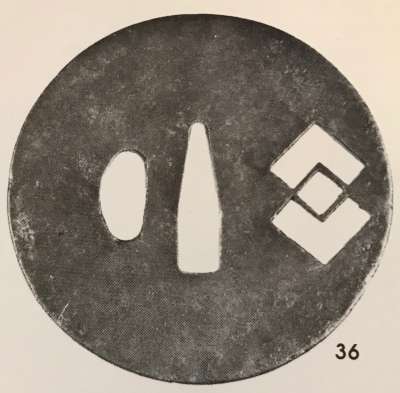Onin Tsuba with two overlapping lozenges, or interlocked diamond shapes.
Iron and brass. Sukashi and ten-zogan technique. Muromachi period.
Diameter: 81.0 mm; Thickness at
seppa-dai: 3.2 mm
The symbol of two overlapping lozenges (or, interlocked diamond shapes), presumably a family crest (
kamon) may be deciphered as
chigai kuginuki (nail extraction tool => 'conquered nine castles' ) or as
chigai bishi (overlapping lozenges). Similar symbol can be found at
Butterfield & Butterfield. IMPORTANT JAPANESE SWORDS, SWORD FITTINGS AND ARMOR. Auction Monday, November 19th, 1979. Sale # 3063], №94 with the following explanation: " This was the
mon (crest) of the
Yonekura family of
Kaga Prov., at
Kanazawa".
An interesting insight is provided by Robert E. Haynes at
Important Japanese kodogu, gaiso and works of art. San Francisco, April 9-11, 1982. Robert E. Haynes, Ltd., № 36 (see photo): "This would seem to be the
Yonekura family mon. They were
Seiwa-Genji Daimyō family made noble in 1696 and resided in
Kanazawa in
Kaga". Would it be possible that this is a late 17th century Ōnin tsuba?

Robert E. Haynes Catalog of April 9-11, 1982, № 36.




